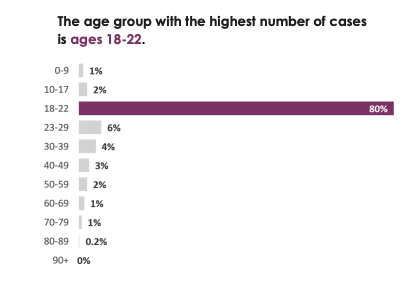
Late Thursday afternoon, Public Health of Madison and Dane County updated their Data Snapshot covering September 1 – 14 with a look at those two weeks’ data, including Department of Health Services’ activity level metric.
The activity level metric measures the burden of cases within the last two week period (number of cases per 100,000) and the trajectory, or the percent change in cases from previous to the current week, and whether or not that trajectory is statistically significant.
According to the update, the current activity level for the county remains high as the trajectory has continued to grow, as it did last week, and the growth continues to be statistically significant. Dane County has grown to 458 cases per 100,000 residents, almost doubling last week’s 242 cases per 100,000.
For all of Dane County, including the University of Wisconsin, a total of 2,380 new cases were confirmed in this two-week period. Of those, 76 percent or 1,818 were from UW. A total of 1,808 UW students and 10 staff. From the 1,808 students:
- 50 (3%) were part of a UW sports team
- 558 (31%) were linked to dorms – no specific dorms were mentioned, but both Witte and are both closed at this time
- 318 (17%) were linked to fraternities and sororities – no specifics were mentioned, but 22 fraternities and sororities are under quarantine at this time
- 521 (29%) were linked to apartment complexes on or near campus that have at least 10 or more cases.
From all cases reported September 1-14, contract tracers have been able to interview 2,202 people and were able to find:
- 1,385 of the 2,380 cases (58%) were associated with a college-aged cluster (this includes the numbers from UW)
- 1,440 (66%) were likely infected by close contact with another lab-confirmed positive case
- 133 or (6%) were associated with a known cluster (not including college-aged housing clusters)
- 22 from health care facilities
- 13 from childcare facilities – 7 of were children (no ages were included) and 6 were adults
- 12 from work places – two from more public-facing workplaces and 10 from less public-facing workplaces
- 8 from congregate facilities
- 8 from UW campus facilities such as dining halls
- 7 from restaurants and bars
- 5 from weddings
- 4 from churches
The largest age group of positive cases from September 1-14 were from the 18-22 age group which made up 80 percent of all cases. Children aged 0-17 only made up three percent of all cases, a total of 78. Children aged 12-17 had 41 total cases, children aged 8-11 grew by 20 cases, children aged 5-7 by six and children aged 0-4 by 11. PHMDC did not provide information of where these children may have been infected.
Dane County averaged 170 new cases per day from September 1-14, up from 94. This metric remains red according to the update and will continue to be red, preventing movement to the next phase of the Forward Dane plan until the county averages fewer than 20 new cases per day to move to yellow and below four cases per day to move to green.
The metric for positive test rate moved into the yellow for the first time, as the county has averaged 5.2 percent for those dates. Our proportion of cases who did not where they might have been infected, however, has improved to 29 percent from last week’s 33 percent. This moves this metric from red to yellow.
For those same date ranges, the percentage of those who test positive that have been contacted within 48 hours of their reported results decreased from last week’s 55 percent to 52 percent. This keeps this metric at red at this time. PHMDC guidelines require it to be 85 percent for it to turn green.
Communities of color are overrepresented in hospitalizations and in cases. According to the snapshot, those who identify as Hispanic/Latinx are underrepresented in all tests. Though six percent of the population, they continue to only be five percent of all tests during that two-week period. Though improved in the overall percentage of all cases from last week dropping from 9 to 7 percent as well as hospitalizations decreasing from 33 percent to 10 percent, the inequity is still concerning for that group. Though for those who identify as either Black or Asian represented only two percent of positive cases from September 1-14, both groups are underrepresented in testing in comparison to their population, with Black people making up 5 percent of tests and Asian people making up only 3 percent of test.
Madison365 will have an update on Dane County’s numbers tomorrow morning.



